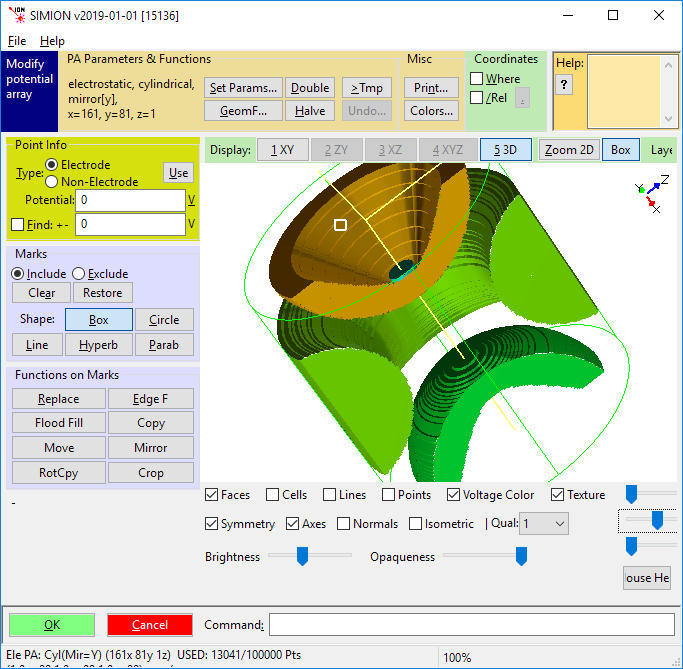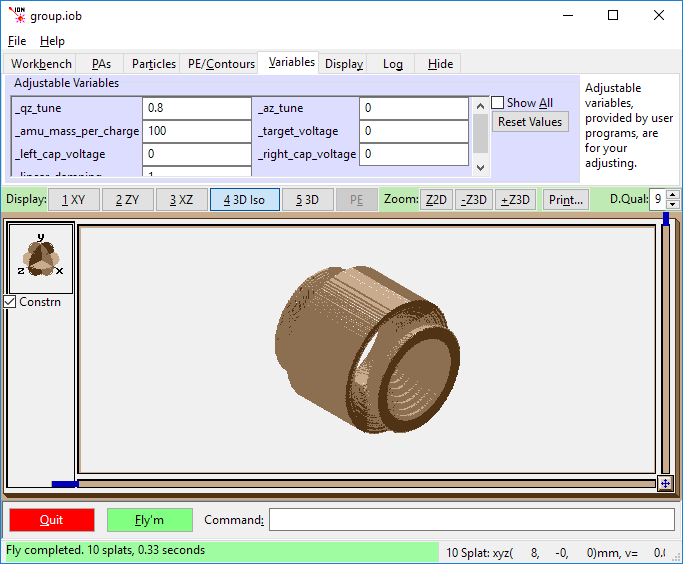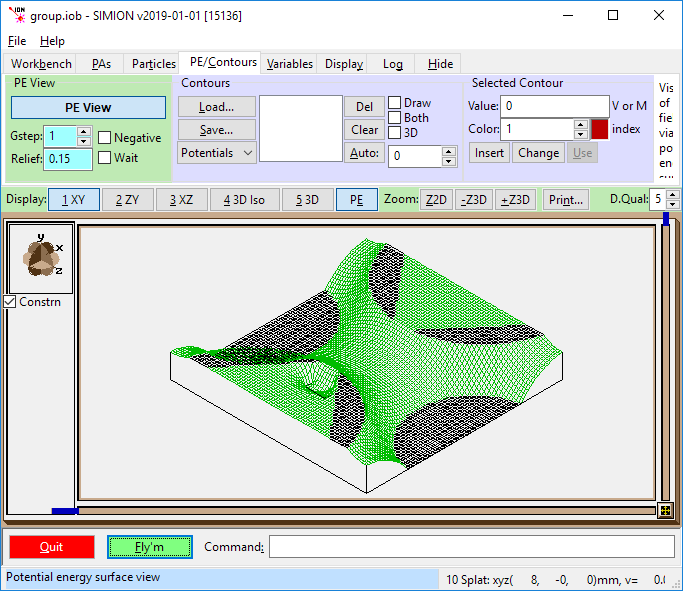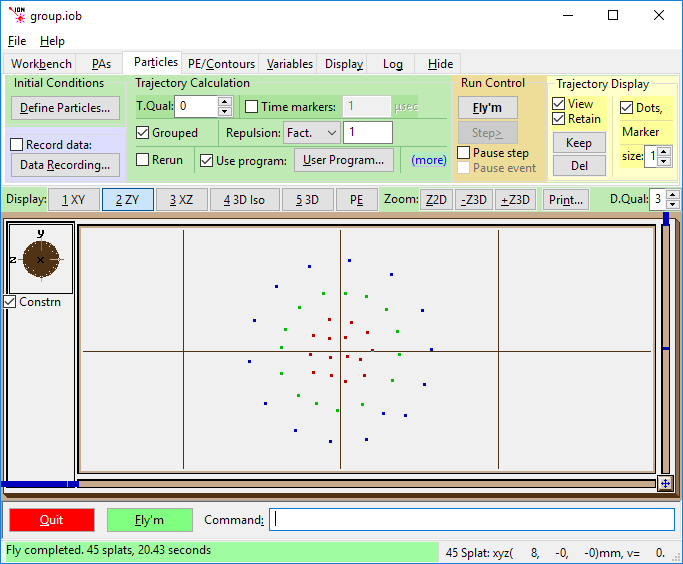Paul Trap¶
A paul trap (quadrupole ion trap) is a type of ion trap that confines charged particles using DC and RF electric fields (not magnetic fields like in a Penning Trap).
SIMION Specific¶
SIMION examples include
SIMION Example: quad - RF linear quadrupole mass filter
SIMION Example: trap - RF ion trap
SIMION Example: octupole - RF linear octupole trap, which is a variant of the RF linear quadrupole trap but with eight electrodes for an octupole field
The
examples\geometryfolder in SIMION 8.0 contains GEM files for a few quadrupole and ion trap geometries.Time-Dependent Field - general notes on RF fields in SIMION
Session 6 “Quadrupole Principles” and Session 7 “Ion Trap Principles” in the Short ASMS Course (
courses\shortfolder in the SIMION 8.0 program directory and also included in SIMION 7.0).About 50 pages of notes on linear ion trap simulations soon plan to be added to Virtual Device , covering analytical theory, SIMION tests, gas flow model, and trap capacity. As of Aug 2011 drafts are in progress.
Screenshots¶

SIMION Modify geometry screen showing 3D quadrupole ion trap.

3D quadrupole ion trap, with adjustable variables.

3D quadrupole ion trap, potential energy view.

3D quadrupole ion trap, particle motion (showing heavy ions in largest shell).
See Also¶
Papers on using SIMION with Paul Traps¶
Papers on simulating Paul and multipole traps with SIMION would be too numerous to list here (hundreds or maybe thousands), but let’s add a few. If you have a paper, let us know to add it to this list. Search Google Scholar for more.
Collision models in ion traps: See Ion-Gas Collisions.
Linear multipole rods and 3D quad
doi:10.1016/S1044-0305(02)00622-0 WilcoxHendrickson2002. Wilcox, Bruce E. Hendrickson, Christopher L. Marshall, Alan G. Improved ion extraction from a linear octopole ion trap: SIMION analysis and experimental demonstration Journal of the American Society for Mass Spectrometry. volume 13, issue 11, year 2002, pages 1304-1312 - linear octupole, SIMION simulations
Raymond E. March, John F. Todd Quadrupole Ion Trap Mass Spectrometry. https://books.google.com/books?id=JDKCoIshgSIC John Wiley and Sons, 2005. - includes SIMION simulations (Chap 4). Also, Practical Aspects of Trapped Ion Mass Spectrometry, Volume V: Applications of Ion Trapping Devices Raymond E. March, John F.J Todd. CRC Press. 2016. https://books.google.com/books?id=r9C6X0yDZDYC
Simulation of Ion Trajectories in a Quadrupole Ion Trap: A Comparison of Three Simulation Programs M. W. Forbes, M. Sharifi,T. Croley, Z. Lausevic and R. E. March. J. Mass Spectrom. 34, 12191239 (1999).
MassSpecPro.com: Linear ion traps tutorial with SIMION videos.
MassSpecPro.com: Quadrupole Ion Trap (QIT)
MassSpecPro.com: Quadrupole Mass Filter
MassSpecPro.com: Multipole Ion Guide
Cylindrical
AustinCruz2006. Austin, Daniel E. Cruz, Dolores, Blain, Matthew G. Simulations of ion trapping in a micrometer-sized cylindrical ion trap. Journal of the American Society for Mass Spectrometry. volume 17, issue 3, year 2006, pages 430-441 doi:10.1016/j.jasms.2005.11.020 - “We have performed detailed SIMION simulations of ion behavior in micrometer-sized cylindrical ion traps (r0 = 1 um).”
Toroidal
YuTang2016. Yu, Quan. Tang, Lijuan. Ni, Kai. Qian, Xiang. Wang, Xiaohao. Computer Simulations of a new toroidal-cylindrical ion trap mass analyzer Rapid Communications in Mass Spectrometry, year 2016 doi:10.1002/rcm.7713 – “toroidal-cylindrical ion trap (TCIT) based on a compact dual ion trap system that comprises an outer toroidal ion trap (T-trap) and an inner cylindrical ion trap (CIT)” “The TCIT is studied by using a simulated mass spectrometer platform that is mainly based on SIMION modeling and extensive data processing. This platform combines different functions, such as simulation of ion motion and field calculations, as well as acquisition of a simulated mass spectrum.”
Cylindrical Toroidal Ion Trap Mass Spectrometer Daniel Austin and Nick Taylor, Brigham Young University. http://hems-workshop.org/8thWS/Presentations/Austin.pdf background overview, pictures, and SIMION simulations. Workshop on Harsh-Environment Mass Spectromet, 8th (2011).
2D Linear ion traps Wikipedia: Linear_ion_trap
SchwartzSenko2002. Schwartz, Jae C. Senko, Michael W. Syka, John E. P. (Thermo) A two-dimensional quadrupole ion trap mass spectrometer Journal of the American Society for Mass Spectrometry. volume 13, issue 6, year 2002, pages 659-669 doi:10.1016/S1044-0305(02)00384-7 “The use of a linear or two-dimensional (2-D) quadrupole ion trap as a high performance massspectrometer is demonstrated.” (highly cited) – with SIMION simulations
Rectilinear
GangYi2015. Gang, Huang. Yi, Chen. Fei, Tang. Li-Tao, Liu. Xiaohao, Wang. Optimization and simulation of MEMS rectilinear ion trap AIP Advances, volume 5, issue 4, year 2015, pages 041303 doi:10.1063/1.4902889 “SIMION software was used to simulate the MEMS rectilinear ion trap with different sizes and different radio-frequency signals.”
Other - Halo, Resistive
Halo Ion Trap Mass Spectrometry: Design, Instrumentation, and Performance Miao Wang. Thesis. Brigham Young University 2010-11-02 http://scholarsarchive.byu.edu/cgi/viewcontent.cgi?article=3457&context=etd - with SIMION simulations. “The halo IT was also based on toroidal trapping geometry and microfabrication technology, consisting of two parallel ceramic plates, the facing surfaces of which were imprinted with sets of concentric ring electrodes. Unlike conventional ITs, in which hyperbolic metal electrodes establish equipotential boundary conditions, electric fields in the halo IT were established by applying different RF potentials to each ring.”
AustinPeng2008. Austin, D. Peng, Y. Hansen, B. Miller, I. Rockwood, A. Hawkins, A. Tolley, S. Novel Ion Traps Using Planar Resistive Electrodes: Implications for Miniaturized Mass Analyzers Journal of the American Society for Mass Spectrometry. volume 19, issue 10, year 2008, pages 1435-1441 doi:10.1016/j.jasms.2008.03.019 - with SIMION simulations. “ion traps in which the electrodes consist of two ceramic discs, the facing surfaces of which are lithographically imprinted with sets of concentric metal rings and overlaid with a resistive material. A radial potential function can be applied to the resistive material such that the potential between the plates is quadrupolar, and ions are trapped between the plates.”
Other - Wire
doi:10.1021/acs.analchem.6b01830 WuLi2016 Wu, Qinghao. Li, Ailin. Tian, Yuan. Zare, Richard N. Austin, Daniel E. Miniaturized Linear Wire Ion Trap Mass Analyzer Analytical Chemistry, volume 88, issue 15, year 2016, pages 7800-7806
Design, Development and Operation of Novel Ion Trap Geometries. Jose Rafael Castrejon Pita. PhD Thesis. The Blackett Laboratory, Imperial College. http://www.imperial.ac.uk/media/imperial-college/research-centres-and-groups/ion-trapping/public/Design-Development-and-Operation-of-Novel-Ion-Trap-Geometries.pdf - wire traps, some SIMION simulations.
More, Uncategorized
10.1016/j.jasms.2008.05.022SalazarMasujima2008. Salazar, G. Masujima, T. Computer Simulation of the Gap-Tripole Ion Trap with Linear Injection, 3D Ion Accumulation, and Versatile Packet Ejection Journal of the American Society for Mass Spectrometry, volume 19, issue 9, year 2008, pages 1367-1374 doi:10.1016/j.jasms.2008.05.022 “The behavior of a completely new ion trap is shown with SIMION 7.0 simulations. The simulated trap, which was a mix of a linear and a 3D trap, was made by axially setting two ion guides with a gap between them.”
